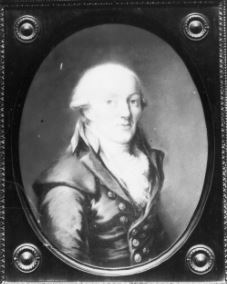Christian Gottlob Langwagen on:
[Wikipedia]
[Google]
[Amazon]

 Christian Gottlob Langwagen (1752,
Christian Gottlob Langwagen (1752,
''Langwagen, Christian Gottlieb 1753–1805.''
o
''Langwagen, Christian Gottlieb.''
@
''Landschaftsgebäude, Braunschweig, An der Martinikirche 8, von Christian Gottlieb Langwagen.''
@

 Christian Gottlob Langwagen (1752,
Christian Gottlob Langwagen (1752, Dresden
Dresden (, ; Upper Saxon: ''Dräsdn''; wen, label=Upper Sorbian, Drježdźany) is the capital city of the German state of Saxony and its second most populous city, after Leipzig. It is the 12th most populous city of Germany, the fourth ...
- 13 August 1805, Braunschweig
Braunschweig () or Brunswick ( , from Low German ''Brunswiek'' , Braunschweig dialect: ''Bronswiek'') is a city in Lower Saxony, Germany, north of the Harz Mountains at the farthest navigable point of the river Oker, which connects it to the ...
) was a German architect who served as a Master Builder
A master builder or master mason is a central figure leading construction projects in pre-modern times (a precursor to the modern architect and engineer).
Historically, the term has generally referred to "the head of a construction project in ...
for the Duchy of Brunswick-Lüneburg
The Duchy of Brunswick-Lüneburg (german: Herzogtum Braunschweig und Lüneburg), or more properly the Duchy of Brunswick and Lüneburg, was a historical duchy that existed from the late Middle Ages to the Late Modern era within the Holy Ro ...
).
Life and work
He was originally astonecutter
Stonemasonry or stonecraft is the creation of buildings, structures, and sculpture using stone as the primary material. It is one of the oldest activities and professions in human history. Many of the long-lasting, ancient shelters, temples, mo ...
, presumably from a poor background. Sometime in the 1770s, he was able to study copper engraving
Engraving is the practice of incising a design onto a hard, usually flat surface by cutting grooves into it with a burin. The result may be a decorated object in itself, as when silver, gold, steel, or glass are engraved, or may provide an in ...
at the Dresden Academy of Fine Arts
The Dresden Academy of Fine Arts (German ''Hochschule für Bildende Künste Dresden''), often abbreviated HfBK Dresden or simply HfBK, is a vocational university of visual arts located in Dresden, Germany. The present institution is the product o ...
. There, he developed an interest in architecture and became a student of the Court Architect, Friedrich August Krubsacius.
Duke Charles William Ferdinand called him to the Royal Seat in 1777 and appointed him Court Architect. Later, he went on study trips to Berlin, Hamburg, and throughout rural Germany. He was also the first Chief Civil Engineer in the Duchy; serving until 1803, when he retired and was succeeded by Peter Joseph Krahe.
Most of the buildings he worked on personally have been demolished or destroyed. From 1786 to 1788, he built a palace for , which became a hotel in 1884 and was largely destroyed in World War II
World War II or the Second World War, often abbreviated as WWII or WW2, was a world war that lasted from 1939 to 1945. It involved the World War II by country, vast majority of the world's countries—including all of the great power ...
. In 1789, he designed the new interior of the , but most of his work was removed in 1868. The (Long Bridge, 1788 to 1791), in south Braunschweig, was demolished in 1879 during work on a canal.
Two outbuildings from the 1780s, at Schloss Richmond
Richmond Castle (german: 'Schloss Richmond') is a castle built from 1768 to 1769 in Braunschweig, Germany for Princess (later Duchess) Augusta, wife of Karl Wilhelm Ferdinand. It lies near the Oker river in the south of the city. The architect w ...
, have been preserved. At the , his portico
A portico is a porch leading to the entrance of a building, or extended as a colonnade, with a roof structure over a walkway, supported by columns or enclosed by walls. This idea was widely used in ancient Greece and has influenced many c ...
was incorporated into the new District Court. Outside of Braunschweig, he created several schools, townhouses and industrial buildings, which have largely not survived. Most of the in Fallersleben
Fallersleben is a part (''Ortsteil'') of the City of Wolfsburg, Lower Saxony, Germany, with a population of 11,269 (as of 2010). The village of Fallersleben was first mentioned in 942 under the name of ''Valareslebo''. Fallersleben became a ci ...
is original.Nicole Froberg, Ulrich Knufinke, Susanne Kreykenboom: ''Wolfsburg. Der Architekturführer.'' Braun Publishing, Berlin 2011, , pg. 23.
References
Further reading
* Norman-Mathias Pingel: "Langwagen, Christian Gottlob". In: Luitgard Camerer, Manfred Garzmann, Wolf-Dieter Schuegraf (Eds.): ''Braunschweiger Stadtlexikon''. Joh. Heinr. Meyer Verlag, Braunschweig 1992, , pg.141. * Horst-Rüdiger Jarck, Günter Scheel (Eds.): ''Braunschweigisches Biographisches Lexikon – 19. und 20. Jahrhundert''. Hahnsche Buchhandlung, Hannover 1996, , pg.370. * Horst-Rüdiger Jarck, Gerhard Schildt (Eds.): ''Die Braunschweigische Landesgeschichte. Jahrtausendrückblick einer Region''. 2nd edition. Appelhans Verlag, Braunschweig 2001,External links
''Langwagen, Christian Gottlieb 1753–1805.''
o
''Langwagen, Christian Gottlieb.''
@
WorldCat
WorldCat is a union catalog that itemizes the collections of tens of thousands of institutions (mostly libraries), in many countries, that are current or past members of the OCLC global cooperative. It is operated by OCLC, Inc. Many of the O ...
''Landschaftsgebäude, Braunschweig, An der Martinikirche 8, von Christian Gottlieb Langwagen.''
@
Bildindex
The Bildindex der Kunst und Architektur is an open online database of 2.2 million photographs of 1.7 million artworks and architectural objects. The owner/operator of this database is the German Documentation Center for Art History known formally ...
{{DEFAULTSORT:Langwagen, Christian Gottlob
1752 births
1805 deaths
Year of birth uncertain
19th-century German architects
Architects from Dresden
18th-century German architects